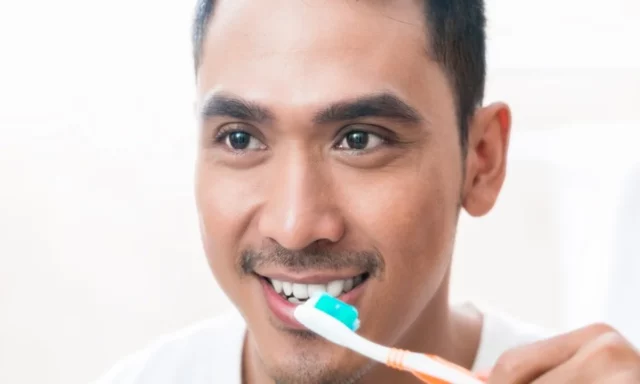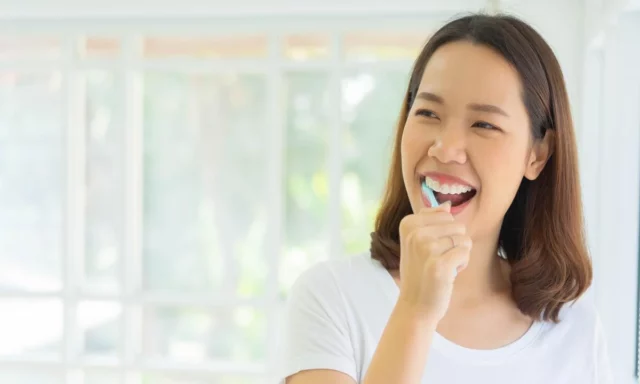Pigments from herbal teas, as well as from other beverages and even solid foods, can leave their mark on teeth. Maybe you are one of those who brush your teeth in the morning after having a coffee for breakfast, or maybe you are one of those who do it before.
In both cases, the question arises: what is the best, to get rid of bad breath from the mouth as soon as we get out of bed or to brush after eating the first meal of the day? Another question also arises: what is the best way to avoid the stains that coffee or other products that we consume produce on our teeth?
Coffee is a popular beverage that, when entering the mouth, inevitably comes into contact with the teeth. It is an acidic liquid -its pH is around 5 on a scale that goes from 1 to 14- and it contains tannins, factors that promote stains on teeth.
But why do these spots form?
The first thing to know is that there are two types: intrinsic and extrinsic. Intrinsic stains are those that are under the dental enamel and that can be congenital or acquired throughout life due to, for example, trauma. The extrinsic ones are the most common, they remain on the surface of the tooth and are caused precisely by the pigments in coffee, tea, red wine, mate (for those from the Southern Cone), soft drinks, juices and some foods such as the red fruits.
“Drinks like coffee or wine have colors –brown, red– so they stain the tooth just as they would stain clothes”, Emily Anderson, dental hygienist at the Association of Dental Hygienists of Florida, United States, explains to BBC Mundo. In any case, among the foods that leave their mark on the teeth, coffee is not one of the worst. “It does not produce as many stains as red wine or some types of teas”, says André Reis, clinical associate professor of dentistry at the University of Florida.

The stain magnet
Once in the mouth, that is where a concept we have heard a lot about in toothpaste commercials comes into play: dental plaque. But what exactly is dental plaque?
It is a colony of bacteria that forms on the teeth. “Those bacteria love to eat the sugars that go into your mouth, and when they do, they produce acids. So it is actually acid attacking the teeth”, says Anderson. And the plate is a great absorbent of pigments. With beverages like coffee, “you will see the stain between your teeth and at the gum line, because that’s where plaque builds up”, says Anderson.
The interaction of food with saliva causes plaque to harden and that is where another concept that appears regularly in advertising is formed: tartar. Most stains are removed with a dental cleaning at the dentist’s office, something that should be done on average 2 times a year, although it varies from mouth to mouth. By removing plaque or tartar, stains disappear.
If in-office cleaning is not enough, the patient can turn to carbamide peroxide or hydrogen peroxide whitening techniques under professional supervision, says Reis (doing so without specialist help can aggravate the situation).
Importance of tooth brushing
The answer to why plaque forms on teeth is generally the same. “For most people, extrinsic staining occurs because they do not brush well or floss properly, if at all”, explains Anderson. For this reason, he recommends a good brushing, gently, directing the brush towards the gum lines and forming small circles, twice a day, and flossing at least once a day after brushing. It is not necessary to hit the brush hard to remove food debris and bacteria from the mouth; on the contrary, doing so damages the gums.
Doing it before drinking coffee has its advantages; the possible plaque that has been generated in the mouth during the night is eliminated and, therefore, the color of the infusion will not adhere so easily. However, both Anderson and Reis agree that the ideal is to do it after the morning meal. “This way you will not build up plaque in your mouth for as long”, says Reis.

What are the benefits of drinking orange juice?
“Simply brushing your teeth before drinking those drinks probably will not help, because the problem occurs over time. It is not just one time you drink coffee. Stains and plaque buildup over time”, says Anderson.
Even more, the healthiest thing for oral hygiene is not to brush your teeth immediately after eating, but to wait half an hour. “Our teeth go through a process of demineralization and remineralization every day. When acids are introduced into the mouth and the bacteria are producing acid with the sugars, the tooth enamel is attacked by the acid”, explains the specialist. “When that process is happening, tooth enamel is vulnerable. So it’s best not to brush on top of that”, she says.
To reduce the interaction of acids with the enamel -and thus reduce the possibility of stain formation-, the advice of the dental hygienist is to drink water immediately after ingestion and thus neutralize its effects.

